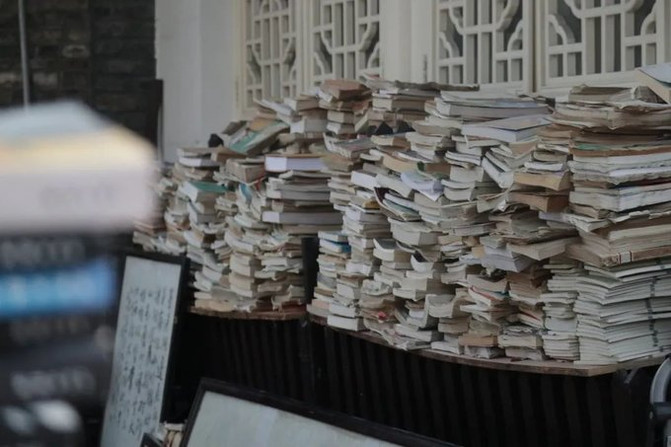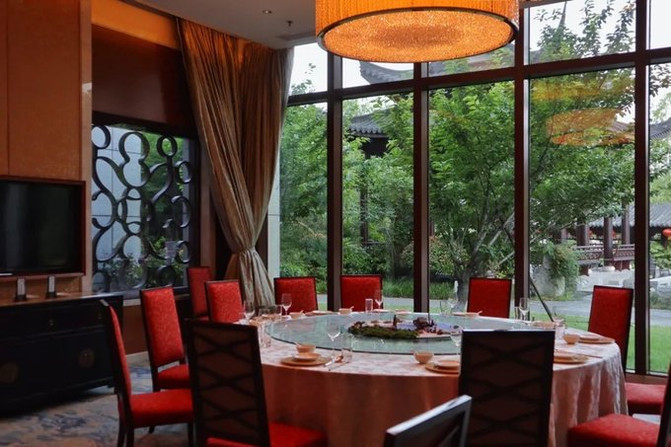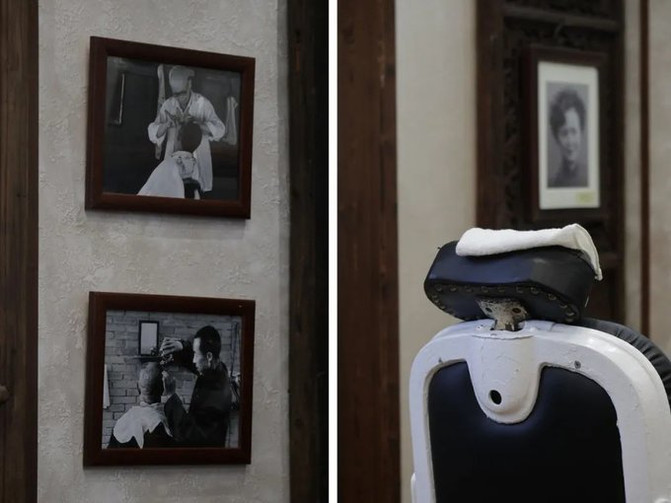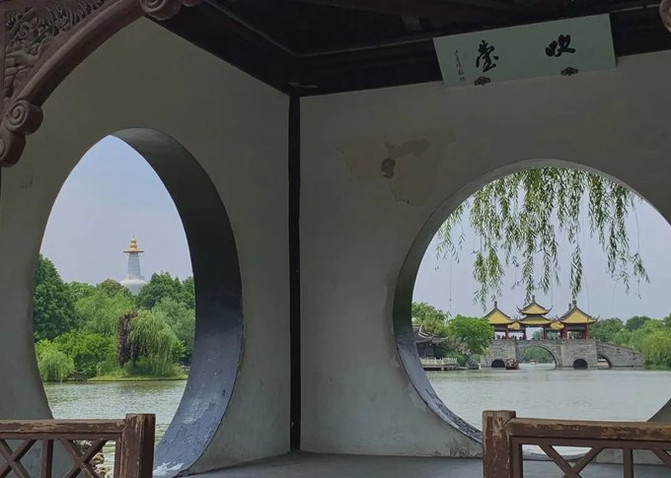Yangzhou| These knowledge points will make your trip to Yangzhou more leisurely

Before going to Yangzhou, I had many questions in my heart.
Why is it called Yangzhou fried rice? Why are the Eight Eccentrics of Yangzhou? Why did Jin Yong have never been to Yangzhou, but put Wei Xiaobao's life experience in Yangzhou? Why did Du Shiniang throw a treasure chest full of money and jewelry into Yangzhou?... ...
After I met Professor Hua Ganlin, I all had answers to piles of questions.

Professor Hua said that ancient Yangzhou was the "dream capital" in people's hearts. Its prosperity allowed those ordinary people and things to be dubbed "Yangzhou", the story would have readers, the food would have a market, and the characters would be even more legendary. Therefore, whether it is Yangzhou fried rice or Wei Xiaobao's story, it will spread quickly.
So, how do you think Yangzhou was the "dream capital" of the ancients?
Professor Hua said that you can know by looking at those popular poems,"With a hundred thousand yuan on your waist, riding a crane down Yangzhou","The Spring Breeze is Ten Miles on Yangzhou Road","Fireworks fall under Yangzhou in March","Life is only for Yangzhou to die","Yangzhou Dream every ten years"... ...
The beauty of travel is that when you come to a famous cultural city and meet scholars like Hua Ganlin who have devoted themselves to studying the city, it is destined that the journey will no longer be as simple as shopping and eating.
As soon as he got on the bus, Professor Hua threw him a question: "Is Yangzhou a southern city or a northern city?"

As a northerner, I have always felt that Yangzhou is a city in the south of the Yangtze River, but geographically, it is located in the north of the Yangtze River. Therefore, the question of whether Yangzhou is north or south has made many people entangled.
To answer this question, we must start with the construction of Yangzhou.

2500 years ago, after defeating King Gou Jian of Yue, King Fu Chai of Wu, became the overlord of the entire southeastern coast. He also had another wish in his heart, which was to dominate the Central Plains. So he sent his troops north and fought all the way to Qi, and soon captured half of the Central Plains. At this time, King Fu Chai of Wu discovered a problem that affected the entire war situation: food and fodder supply.
At that time, if you wanted to go from Gusu, the capital of Wu, to Linzi, the capital of Qi, you had to cross three rivers: the Yangtze River, the Huaihe River, and the Yellow River. At that time, the Yangtze River was very wide, 25 kilometers long. This was an insurmountable chasm for the Wu State, which was advancing north, meaning that the troops were in front and the food and fodder could not keep up.

In order to solve this problem as soon as possible, in 486 BC, King Fuchai of Wu built a city called Hancheng on the hilly land north of the Yangtze River, and opened a ditch called Hangou. When Hangou connected the Yangtze River and Huaihe River, worries were solved. Hangou is the earliest recorded section of the Grand Canal dug in history. It is considered to be the beginning of the Beijing-Hangzhou Grand Canal.
King Fuchai of Wu moved some people of Wu to Hancheng. Until the Sui Dynasty, they all spoke Wu dialect and lived in the south. Later, with the integration of the Civil War, Yangzhou was influenced by northern culture and formed its current appearance.
Professor Hua concluded: "Yangzhou has both the elegance of southern culture and the grandeur of northern culture. It is the only city among Chinese cities."

If you go to Yangzhou for a vacation, uncle will definitely recommend Shangri-La Hotel Yangzhou.
First of all, there are only a handful of high-quality hotels in Yangzhou, and they are committed to everything from quality to service;
Secondly, Huaiyang cuisine should not be missed when you come to Yangzhou. Everyone who lives in hotels knows the saying "Eat in Shangri-La";
Once again, Yangzhou
"Three Knife" CultureIt has settled in Yangxiang and has become a living sign of the hotel. Therefore, if you live in Yangxiang without leaving your home, you can also enjoy the wonderful experience brought by Yangzhou culture.




When it comes to Huaiyang cuisine, you will definitely mention kitchen knives. At Shangri-La Hotel in Yangzhou, there is a big meal that must not be missed. It comes from Zhou Xiaoyan, the intangible cultural heritage inheritor of Huaiyang cuisine, who participated in the filming of "A Bite of China 2", and is known as the "first knife" of the three knives in Yangzhou. He and Yang Xiang restored the "Ming and Qing Dynasties Salt Merchants Family Banquet".

Why restore Huaiyang cuisine with Ming and Qing salt merchants 'family banquets? This is due to Kangxi's unblocking of the canal, which not only provided food and clothing in the capital, but also laid the foundation for the prosperous years of Kangxi and Qianlong. As a transportation hub, Yangzhou has once again become a place where merchants and capital gather.
Merchants from all over the country came to Yangzhou to make money. During the Qianlong era, Yangzhou's salt merchants provided half of the national economy's tax revenue, which also provided opportunities for the salt merchants 'chefs to improve. When salt merchants entertain guests, the cooking skills of their own chefs have also become a capital to demonstrate their strength, and the "competition of vegetables" of banquets has also become a kind of catering culture.

Huaiyang cuisine is different from the seafood of Cantonese cuisine and the delicacies of Sichuan cuisine. Most of the ingredients of Huaiyang cuisine come from rice, aquatic products, poultry, etc. in Jiangnan. So how can we reflect the exquisiteness of the food? One is to choose the best among ordinary ingredients, and the other is to pay attention to artistic sense in knife skills, which has created the kitchen knife skills of Huaiyang chefs.

At this Ming and Qing Dynasty salt merchants 'family banquet, you can eat thin wing-like cucumbers, specially selected duck breasts, Gaoyou's double yellow eggs, as well as perch and bean sprouts stuffed with thin hair. Ham, etc. In short, the exquisiteness of ingredients and the exquisite cooking are all included in this meal.



In terms of taste, it is also like Yangzhou's geographical location. It has both the sweetness of the south and the salty and fresh dishes of the north. It is precisely because of this that Huaiyang cuisine became the first banquet of the founding of the country, suitable for both north and south.
Another delicious meal that you can't miss in Yangxiang is "Yangzhou Morning Tea".

Yangzhou people's habit of eating morning tea is also related to salt merchants. At that time, salt merchants would have a council every morning to agree on issues such as the salt price of the day, and then start a day of business. The morning meeting developed the habit of taking turns serving morning tea every day. The salt merchants reciprocated with courtesy on the surface, and the level of morning tea in each family became a place to show their soft power. Therefore, they secretly "competed for morning tea", and each family worked hard on new tricks, new craftsmanship, and new eating methods, which ultimately achieved the essence of Yangzhou morning tea culture.



People who travel to Yangzhou will choose to have morning tea, and most people will go to the time-honored brands. As a result, they often queue up first, check their faces, and then rush to eat it, and then feel full when they are full. Uncle's suggestion is that we should come to the Xianggong of Shangri-La Hotel in Yangzhou for morning tea, look at the green "Liuyuan" garden, and easily taste the meticulous preparation of each tea. Compared with the traditional morning tea shops in the market, this is also a "morning tea fight".








In terms of material selection, craftsmanship, environment, taste, service, and cost performance, Yangxiang's morning tea is not even better. Finally, I would like to remind everyone to pay attention when eating crab powder soup dumplings. Eat them in three steps: slowly carry them, move them slightly, and suck them gently to avoid being burned.


Tianzi Barber Shop, a representative of Yangzhou's barber industry, has also settled on the third floor of the hotel. In fact, when I heard that my friends wanted to experience face-fixing services, my first reaction was to refuse. After all, I don't like others doing "knife" on my face. When I stood next to my friends and silently watched them look completely new after finishing face-fixing, I immediately decided to give it a try.

The experience of facial repair is only for men and can help men remove excess hair and oil on their faces. The masters in the store are all veterans who have been in the industry for twenty or thirty years. Lying on the chair, the old master performed "seventy-two-a-half knives" on my face. After the repair, I directly bleached two color number. It's really amazing.

Here you can experience the subtleties of "taking care of the world's top priority and working hard as a human being."
When it comes to contemporary Yangzhou drill foot culture, we have to mention Lu Qin, the inheritor of intangible culture. She opened the Lu Qin Foot Art flagship store to the third floor of the hotel, allowing guests who have been playing for a day to completely relax and enjoy it.

Before I experienced Lu Qin's pedicure, I always thought this was just a pedicure place. After experiencing it, I realized that I had completely misunderstood it. A master with many years of technology will first help you massage and relax through unique techniques. The unique foot experience is in the second half of the day, and finally cupping and drilling feet will help you do physical therapy and beauty treatment for your feet.

It was definitely a super enjoyable experience. The master told me that when I come back next time, I suggest not to cut my toenails half a month in advance. Let him come and help me handle them properly and give me a pair of healthy and clean feet.

Note: When you are on vacation in Yangzhou, you choose to stay at Shangri-La Hotel, Yangzhou. In addition to the projects recommended by uncle, you can also visit the Chinese Engraving and Printing Museum next to the hotel. Museums have been popular in the past two years. When you have been to Slender West Lake, He Yuan, Ge Yuan and other attractions, you may wish to visit the museum.

It is said that Suzhou gardens are the best in the world, but the area of all Suzhou gardens combined is less than half of the size of Slender West Lake. Suzhou gardens are famous all over the world because the railway was built to Suzhou in 1898, and Suzhou became the back garden of the people of Shanghai. However, to this day, there is no direct train from Shanghai to Yangzhou. What is worth looking forward to is that in July, two weeks, starting from Shanghai, it takes only 2 and a half hours to reach Yangzhou.

Yao He, a poet in the late Tang Dynasty, described Yangzhou's poem "Most gardens are houses, and chariots and horses are less than ships", which shows that Yangzhou was full of gardens during the Tang Dynasty. In the heyday of Kangxi and Qianlong, there were more than 100 gardens of large and small in Yangzhou City. Salt merchants without private gardens in the city were looked down upon.

During the Qianlong era, there was a scholar named Liu Daguan who said this: Hangzhou wins with lakes and mountains, Suzhou wins with its cities, Yangzhou wins with its garden pavilions, and Yangzhou wins with its garden pavilions. Although modern Yangzhou made some gardens desolate, now garden life has gradually returned to people's daily life. It is said that there are more than 300 private gardens.

Slender West Lake has a history of more than 300 years. It is a combination of many private gardens in ancient times. Many gardens have been built along both sides of the waterline. The landscape of pavilions and pavilions does not duplicate. It is ten miles long and ends up with Ouyang Xiu's Pingshan Hall. Compared with Suzhou gardens, this place not only retains the original nature, but also has the style of a royal garden.




The most vivid part of a city is the streets and alleys filled with fireworks, while the small streets and alleys in Yangzhou retain the original Ming and Qing architecture. More than 500 alleys crisscross each other, becoming another business card of the city. Whether you are a middle-aged man who likes history or a young man who likes coffee, you can find something that touches you in these alleys.



Guqin culture has a long history in Yangzhou, dating back to 1500 years. Guangling was the ancient name of Yangzhou. Ji Kang, a guitarist in the Wei and Jin Dynasties, died generously after playing "Guangling San" on the guillotine. From then on,"Guangling San" was widely spread. This is a guqin song related to Yangzhou. In modern China, nine major qin schools were formed, including the Guangling Qin School.

In history, every prosperity of Yangzhou was inseparable from canals. Emperor Yang of the Sui Dynasty extended the Grand Canal. The Yangtze River ran east-west and the Grand Canal ran north-south. Yangzhou became a water and land hub at the crossroads.

By the Tang Dynasty, Yangzhou became the largest dock in China. After the An-Shi Rebellion, the capital had no food, drink, or taxes, and the rebels did not come to the south. Yangzhou still remained peaceful. Scholars, literati, and wealthy businessmen came here one after another, making Yangzhou the only city to open a night market. In "Watching Yangzhou City at Night" written by the poet Wang Jian of the late Tang Dynasty, a scene of peaceful singing and dancing: the night market shone on the blue clouds, and high-rise tourists were crowded with red sleeves. Nowadays, it is not like the times, but it is still heard from the beginning of singing and dancing. Now that the Grand Canal is included in the World Heritage List, Yangzhou is the most historic place on this river.

In 2007, Yangzhou became the third city in China to win the United Nations Best Habitat Award. Before that, there were only two cities in China, one was Weihai and the other was Zhuhai. They both won this honor through marine culture. As an inland city, Yangzhou relied on its rich ancient cultural heritage and modern civilization to win this honor.
Previous Article:48-hour tour of Yangzhou: visit Slender West Lake, eat Huaiyang cuisine, visit the "Imperial Garden", enjoy flowers and moonlit night
Next Article:Jiangsu Tour Experience 3: Private Garden
